Five Year Highway & Transit Bill with Funding Increases Better Option
November 16th, 2015 | By: America's Infrastructure Report Card
Last week, transportation stakeholders sent a letter to the House and Senate surface transportation conference committee in support of a robust five year highway and transit bill that would increase investment levels. The House-passed bill includes a $40 billion offset which could help increase investment levels if the duration of the bill were reduced from six years to five. A budget analysis conducted by the Eno Center for Transportation estimates that if the money is evenly distributed between highway and transit programs, that a five year bill with a seven percent funding increase in fiscal year 2016 and a three percent annual funding increase thereafter would be the result. On Monday, ASCE along with a larger coalition sent a letter to conferees in support of increase funding for the federal TIFIA program. The TIFIA program provides federal credit assistance in the form of direct loans, loan guarantees, and standby lines of credit to finance surface transportation projects of national and regional significance. The Federal Highway Administration’s Office of Innovative Program Delivery notes that for every dollar in federal investment through TIFIA, the program can deliver ten dollars in credit assistance which can be leveraged into thirty dollars in overall transportation infrastructure investment. The House and Senate have named most of their conferees, with the remaining House members likely to be named by the time the first public conference committee meeting takes place this week. Monday, the House unveiled a two week extension of the current law until December 4 to allow the conference committee time to complete their work. Until the conference committee produces a final bill, ASCE remains engaged in a targeted advocacy push to educate member of the committee on ASCE’s key positions. Please continue to check this blog regularly for issue updates over the coming days.House Passes Six-Year Highway & Transit Bill
November 6th, 2015 | By: America's Infrastructure Report Card
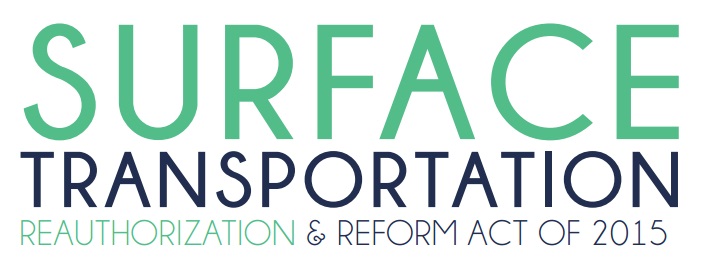 Yesterday, newly-minted House Speaker Paul Ryan (R-WI) shepherded through his first piece of major legislation with bipartisan passage of a six-year, $325 billion surface transportation reauthorization bill. The Surface Transportation Reauthorization & Reform (STRR) Act of 2015 cleared the House by a vote of 363-64. A last-minute amendment was added to STRR that secured an additional $40 billion in revenue from an unused Federal Reserve account. This means that while the House bill is now funded for a full six-years, it still does not increase highway and transit funding levels over the current amount.
Following the bill’s passage, ASCE President Mark W. Woodson, P.E., F.ASCE, released a statement saying, “While the House-passed bill provides six years of stability for the nation’s road, bridge, and transit programs, it fails to increase funding to levels that are adequate to properly maintain our infrastructure.” Mark went on to state that, “ASCE is disappointed that House leadership prevented a vote on raising the federal gas tax – a policy solution that would have provided long-term funding and certainty that states desperately need to move forward with their transportation projects.” ASCE endorsed multiple amendments that were offered to raise the gas tax, including one by Rep. Earl Blumenauer (D-OR), however none of those amendments were allowed to receive a full vote on the House floor.
An amendment that was defeated, which ASCE weighed-in against, was a sense of Congress resolution introduced by Rep. Ron DeSantis (R-FL) in support of the concept of devolving the federal transportation program to the states.
Some highlights of the House bill include:
• Multi-year program certainty that will help states and localities better plan and deliver projects;
• Accelerated project delivery reforms aimed to improve collaboration between agencies and create deadlines for agency action(s);
• Providing grants to states for continued and expanded pilot testing of future road user fee collection systems;
• A new competitive grant to address bus and bus facility needs;
• Increased focus on funding for roadway safety infrastructure and on the safety needs of rural roads; and
• An option for localities to bundle small projects such as bridges to increase efficiency.
The House vote follows previous Senate action in July on its surface transportation bill, which provided only three years of funding although at much higher levels. Now the House and Senate will work to negotiate a compromise before the looming November 20 deadline. ASCE will be reviewing the House and Senate bills to determine which provisions we favor to be included in any final agreement. On funding, ASCE urges a final bill be multi-year with sizable funding increases for highway and transit programs. Be sure to check this blog regularly in the coming days and weeks to get more updates on how you can help our advocacy effort to #FixTheTrustFund.
Yesterday, newly-minted House Speaker Paul Ryan (R-WI) shepherded through his first piece of major legislation with bipartisan passage of a six-year, $325 billion surface transportation reauthorization bill. The Surface Transportation Reauthorization & Reform (STRR) Act of 2015 cleared the House by a vote of 363-64. A last-minute amendment was added to STRR that secured an additional $40 billion in revenue from an unused Federal Reserve account. This means that while the House bill is now funded for a full six-years, it still does not increase highway and transit funding levels over the current amount.
Following the bill’s passage, ASCE President Mark W. Woodson, P.E., F.ASCE, released a statement saying, “While the House-passed bill provides six years of stability for the nation’s road, bridge, and transit programs, it fails to increase funding to levels that are adequate to properly maintain our infrastructure.” Mark went on to state that, “ASCE is disappointed that House leadership prevented a vote on raising the federal gas tax – a policy solution that would have provided long-term funding and certainty that states desperately need to move forward with their transportation projects.” ASCE endorsed multiple amendments that were offered to raise the gas tax, including one by Rep. Earl Blumenauer (D-OR), however none of those amendments were allowed to receive a full vote on the House floor.
An amendment that was defeated, which ASCE weighed-in against, was a sense of Congress resolution introduced by Rep. Ron DeSantis (R-FL) in support of the concept of devolving the federal transportation program to the states.
Some highlights of the House bill include:
• Multi-year program certainty that will help states and localities better plan and deliver projects;
• Accelerated project delivery reforms aimed to improve collaboration between agencies and create deadlines for agency action(s);
• Providing grants to states for continued and expanded pilot testing of future road user fee collection systems;
• A new competitive grant to address bus and bus facility needs;
• Increased focus on funding for roadway safety infrastructure and on the safety needs of rural roads; and
• An option for localities to bundle small projects such as bridges to increase efficiency.
The House vote follows previous Senate action in July on its surface transportation bill, which provided only three years of funding although at much higher levels. Now the House and Senate will work to negotiate a compromise before the looming November 20 deadline. ASCE will be reviewing the House and Senate bills to determine which provisions we favor to be included in any final agreement. On funding, ASCE urges a final bill be multi-year with sizable funding increases for highway and transit programs. Be sure to check this blog regularly in the coming days and weeks to get more updates on how you can help our advocacy effort to #FixTheTrustFund.
House Readies for Action on Surface Transportation Bill
October 29th, 2015 | By: America's Infrastructure Report Card
 Yesterday, Congress enacted a short-term extension of current highway and transit program authority before the looming deadline of October 29. The current authorization and solvency of the federal Highway Trust Fund will now expire on November 20, which gives Congress about three more weeks to conclude a few important remaining steps in the process of completing work on a surface transportation bill:
Yesterday, Congress enacted a short-term extension of current highway and transit program authority before the looming deadline of October 29. The current authorization and solvency of the federal Highway Trust Fund will now expire on November 20, which gives Congress about three more weeks to conclude a few important remaining steps in the process of completing work on a surface transportation bill:
- Next week the House will take-up and likely pass its own six-year transportation bill which provides flat-line funding for the next three years;
- Immediately thereafter, the House and Senate will convene a conference committee and work quickly to produce a compromise bill;
- The House and Senate will then have to pass an identical bill through each chamber before it can be sent to President Obama for his signature, hopefully before the November 20 deadline.
It’s Off to the Races on a House Highway & Transit Bill
October 14th, 2015 | By: America's Infrastructure Report Card
Today, the chairman of the U.S. House of Representatives Committee on Transportation & Infrastructure (T&I) Bill Shuster (R-PA) announced that his committee would be holding a mark-up of a surface transportation authorization bill on October 22. The bill, text of which has not yet been finalized is titled, the Surface Transportation Reauthorization and Reform Act of 2015. In making the announcement, Shuster noted that the bill would, “reform programs, refocus those programs on national priorities, provide more flexibility and certainty for state and local partners, and welcome innovation.” The markup is set to begin at 10:00AM ET next Thursday and will be livestreamed here .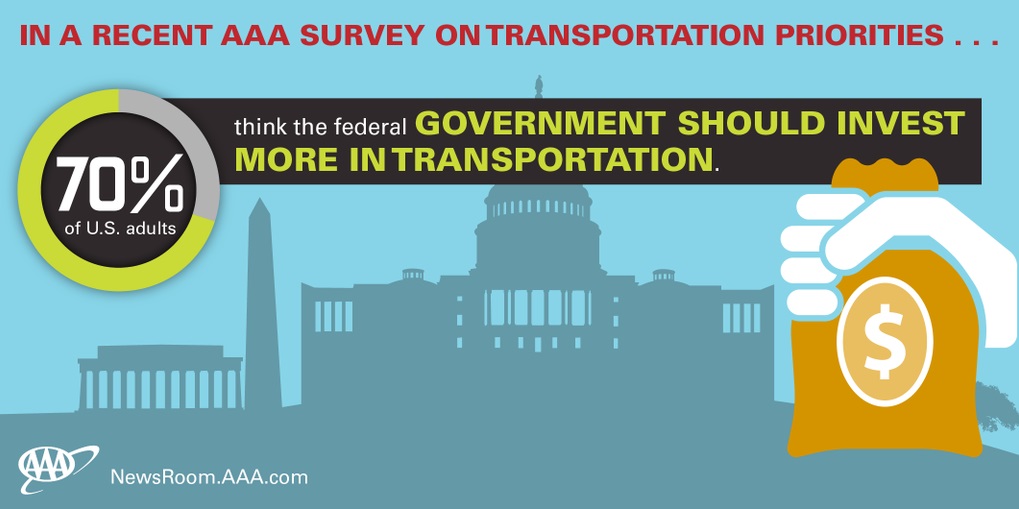 The announcement comes after legislative progress this summer by the U.S. Senate which passed the DRIVE Act that provides three years of increased funding and six years of policy for federal road, bridge and transit programs. This funding increase is supported by a large majority of Americans as demonstrated in a recent public survey by the motor club AAA. The survey found that 70% of respondents believed that the federal government should invest more than it does now for roads, bridges and mass transit systems. The survey also found that only 38% of Americans believe that Congress is taking the necessary steps to ensure that our roads, bridges and transit systems will meet the needs of the nation.
Please let your House members know you support them moving forward quickly on legislation that provides multi-year certainty and increased funding levels for highway and transit programs.
The announcement comes after legislative progress this summer by the U.S. Senate which passed the DRIVE Act that provides three years of increased funding and six years of policy for federal road, bridge and transit programs. This funding increase is supported by a large majority of Americans as demonstrated in a recent public survey by the motor club AAA. The survey found that 70% of respondents believed that the federal government should invest more than it does now for roads, bridges and mass transit systems. The survey also found that only 38% of Americans believe that Congress is taking the necessary steps to ensure that our roads, bridges and transit systems will meet the needs of the nation.
Please let your House members know you support them moving forward quickly on legislation that provides multi-year certainty and increased funding levels for highway and transit programs.
Transit and Water Needs Capture Media Attention
September 25th, 2015 | By: Olivia Wolfertz
With the Pope making his way across our northeastern cities, the topic of traffic congestion was a popular one, highlighting our nation’s transportation needs. The Onion even joked that the Pope even tried to improve the nation’s ailing infrastructure. While not directly related to the Pope’s visit, this week in D.C., the subway system suffered an electrical fire and outage, resulting in the evacuation of passengers and extreme delays. While traffic increases are predictable during major events, our existing transit systems should be able to handle increased ridership without breaking down. Fortunately, the number of recent incidents in the D.C. subway system have prompted the Federal Transit Administration (FTA) to approve a correction action plan to make the system more reliable. Water infrastructure needs have been gaining more spotlight lately due to increased media attention. In Iowa, Des Moines Water Works, which is critical to providing water for to the Central Iowa region, is showing signs of aging and is in great need of repair. “We’re reaching the end of the life cycle of some of the most critical assets we’ve got,” said Bill Stowe, CEO and general manager of the utility. Water infrastructure needs are also evident in New Hampshire, where the cost needed to repair aging systems, including pipes and treatment plants, could be as much as $1 trillion. In response to these needs, water providers, agencies, utilities, elected officials, corporations and environmental advocates across the country are joining together to educate the public about the challenges facing water and wastewater systems, and the need for investment. A nationwide event, Imagine a Day Without Water, will be held Oct. 6-8 in events across the country to emphasize how essential water is and the importance of maintaining water and wastewater infrastructure. Meanwhile, additional states are taking action to repair their surface transportation infrastructure. Tennessee, Texas, New Jersey, Oregon and Alaska are considering raising their state gas tax, among other options, to fund their transportation. Whether it’s improving transit, maintaining water infrastructure or re-paving our roads, federal funding is essential. As we await the House Transportation & Infrastructure Committee’s mark-up of its multi-year surface transportation bill, write your members of Congress and urge them to pass a long-term transportation bill by the October 29 deadline.Highway Fund in Trouble by November 20th
September 23rd, 2015 | By: America's Infrastructure Report Card
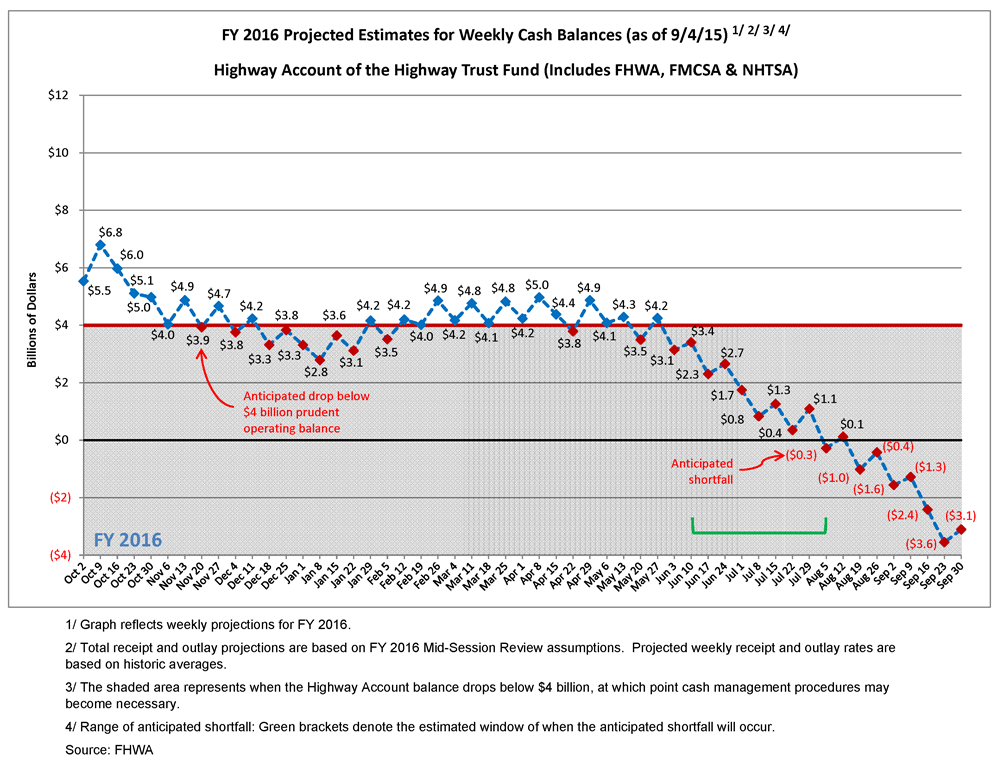
GRAPH: Cash balance estimates of the Highway Account of the federal Highway Trust Fund; courtesy of the Federal Highway Administration
- October 29, which, following a July extension, is the new date to pass a renewal of the HTF authorization; and
- November 20, which is the projected date when federal funding will slow and be reduced to states.
Secretary Foxx to Congress: Raise Your Sights
September 9th, 2015 | By: America's Infrastructure Report Card
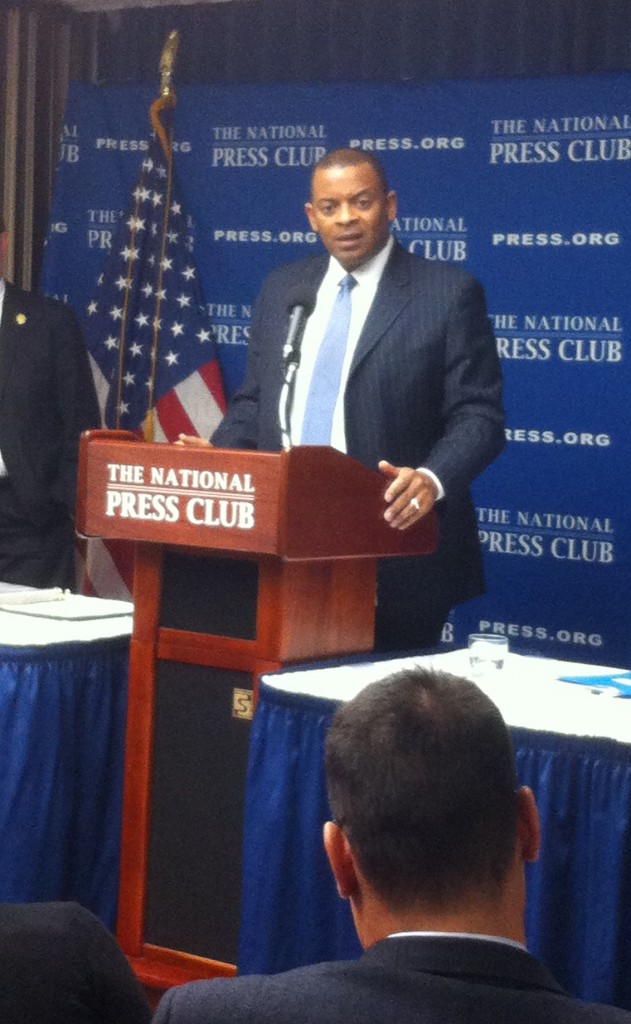
U.S. Department of Transportation Secretary Anthony Foxx speaks at the National Press Club; 9/9/15 – Photo by ASCE
Despite Senate Transportation Action, House Stymies Progress
July 30th, 2015 | By: America's Infrastructure Report Card
During the last two months, the Senate made good use of its time to craft a multi-year surface transportation bill with an increase in funding. As is often the way for Congress, it still came down to the wire. For over a week, the U.S. Senate has been in a mad dash to complete its work on a multi-year surface transportation bill before the looming July 31 legislative deadline hits. With the help of ASCE members, fellow coalition members including Associated General Contractors, the American Road and Transportation Builders Association, the U.S. Chamber of Commerce, many other groups, and the public, the Senate was successful in doing so – with even a little bit of time to spare. Today the Senate delivered to the House for consideration a six-year, $350 billion road, bridge and transit policy bill that provides three-years of dedicated funding and boosts current investment levels. The only problem? The House is not in session to take it up and pass it before the Friday deadline. In the Congressional equivalent of ding-dong-ditch, yesterday the House passed and sent to the Senate a three-month program extension just as House members left town for August recess, which meant the Senate had no option but to pass the three-month extension in order to avoid a program shutdown on July 31. So in the end the Senate was successful in doing its work, but was unable to get their effort signed into law by the July 31 deadline because the House left town early and refused to take it up. The Senate bill’s funding increases for highway and transit are a step in right direction, but still far below the investment levels America needs to address its aging roads, bridges, and transit systems. However, when compared to the horrible status-quo that the federal program finds itself in – a seemingly endless cycle of short-term extensions combined with a continued deterioration of the purchasing power of transportation dollars – the Senate bill was the most promising legislation proposed during the two-month extension. “In the next three months, ASCE urges the House and Senate to work through their policy differences and continue the legacy of the Highway Trust Fund,” said Tom Smith, ASCE’s executive director. “This short-term extension needs to be the last and we believe it can be, so long as Congress moves the nation forward by working together in a bipartisan way to finish their work on improving America’s surface transportation infrastructure.” Of note the Senate bill: • Provides six years of policy reforms and contract authority for highways and transit programs, thus ending the cycle of short-term, multi-month program extensions; • Provides three years of dedicated revenue to the Highway Trust Fund (HTF) so states can deliver more long-term projects; • Increases funding levels for both highway, transit and passenger rail programs in order to reduce our nation’s maintenance and construction backlog; • Provides for a new national dedicated freight program to improve goods movement; • Contains bipartisan permitting reforms that would set deadlines for project decisions, increase transparency and reduce litigation delays; and • Contains a federal pilot program for future user-fee revenue generating systems like those currently being tested in some states regarding vehicle miles traveled (VMT). While the summer legislative battle is over and victory was confined to the U.S. Senate, transportation advocates will take the August break and recharge our batteries to be ready for the final fall push when Congress is back in September. Please take a moment to see how your Senator voted and thank him/her on their leadership this July. We will need their support again soon enough once a final House and Senate compromise comes together.Five (More) Myths About the Highway Trust Fund
July 15th, 2015 | By: Becky Moylan
1. Devolving the federal program to the states is a viable option Devolution is the idea of eliminating the federal government’s ability to collect the current 18.4 cents per gallon in federal gasoline taxes (absent a few cents to remain dedicated toward maintaining the Interstate Highway System) and transferring all authority over these programs to the state. This act would represent one of the single greatest unfunded mandates at nearly $50 billion—a violation of the Unfunded Mandates Reform Act of 1995. The current system empowers states by making the federal role a reimbursement process, allowing states to make their own planning and building decisions while also having some overall coordination and safety standards among states. Many states have raised their own gas taxes recently, essentially catching up the purchasing power of their current gas tax rates with inflation since they were last adjusted. For example, Iowa had not raised its gas tax since 1989 and its 10-cent increase was a hard fought battle. To ask states to pick up the tab for the federal role—which on average is 52% of the state’s capital budget each year—would be a huge burden to states’ budgets. On average, states would need to raise their gas tax by 23 cents or significantly cut their transportation program. It would not be the easy task that the proponents of devolution make it out to be. Instead, our roads, bridges and transit would continue to deteriorate and the backlog of projects would grow longer and the system will become patchwork if some states fail to make investments. 2. Transportation has become a partisan issue Transportation has historically been a bipartisan issue, and passing a multi-year, properly funded transportation bill will only be accomplished through bipartisan cooperation. In the past year, there have been several bipartisan proposals to help address the Highway Trust Fund crisis. Senators Bob Corker (R-TN) and Tom Carper (D-DE) have proposed a plan. In the House, Reps. Renacci (R-OH), Pascrell (D-NJ), Ribble (R-WI), and Lipinski (D-IL) have introduced the Bridge to Sustainable Infrastructure Act. Before the Independence Day Recess, the Senate Committee on Environment & Public Works unanimously passed the DRIVE Act out of committee. Both sides of the aisle acknowledge that our transportation system is ailing and that something must be done. Fixing the Highway Trust Fund is, at its heart, a bipartisan endeavor. 3. Flat funding is fine If Congress does not grow the program and increase federal funding levels in the next multiyear transportation bill, then our economy will continue to suffer. In 2011, ASCE released an economic study on transportation titled Failure to Act, which details how underinvesting in transportation is a drag on our economy. The study outlined what the economic ramifications will be by 2020 if status quo funding levels continue. Among them, we revealed that America’s GDP will underperform by $897 billion in total by 2020 and each family’s budget loses $1,060 each year in disposable income—money every American household has already lost and will continue to lose if we don’t improve our transportation network. Underinvestment in transportation will cost our economy 877,000 jobs in the year 2020. Continuing to fund at current levels for the next several years will neither improve our aging transportation network, nor grow the economy 4. A gas tax is not politically possible Several states have recently acted in bipartisan fashion to pass gas tax increases. In those states, 90% of those who voted in favor the gas tax increase got reelected in the following election. And many were conservative states, like Arkansas, which needed to see a high return on investment. A poll by the Mineta Transportation Institute demonstrated that people are willing to pay more in gas taxes if it goes to improving transportation. This study shows that voters recognize the connection between potholed roads and aging bridges and underinvestment. In addition, the impact of a gas tax on gas prices is not as direct as sometimes thought. A recent study by ARTBA finds that gas tax increases have very little impact on the overall price of a gallon of gas. CBO projects that the Highway Trust fund’ revenue shortfall will be $8 billion at the end of this year and be between $85 billion and $90 billion by May 31, 2021. There is no reason to add to the national debt and our burden on future generations when raising the gas tax is a deficit-neutral options. 5. We can kick the can again Two-month stopgaps hurt the economy and American business. For two consecutive years, the summer highway and transit construction season has taken a hit because of the uncertainty surrounding the federal program. For example, just in the last few weeks and months, several states have announced they are canceling or delaying projects until Congress passes a multi-year bill. These short-term extensions not only delay existing projects in the pipeline but prevent major projects from being considered in light of the lack of a clear federal funding commitment. Ultimately the lack of certainty hinders our nation’s ability to dream big on ways to modernize our infrastructure and create the foundation for the 21st century economy. See the original posts 10 Myths About the Highway Trust Fund.#FIXTHETRUSTFUND This Week: Time for Congress’ Next Move
July 6th, 2015 | By: Becky Moylan
 Congress returns to D.C. this week, and we’re watching the Senate (where the most promising legislation was recently passed through the EPW Committee) to see if the Senate Commerce Committee or the Senate Banking Committee will start to mark-up their portions of the highway and transit bill. However to truly move forward, Senate leadership and the Senate Finance Committee need to find the revenue to move the DRIVE Act forward.
With just 16 working days with both chambers in session before the July 31 deadline, it’s important that Congress hear from you. Drive Congress to #FixTheTrustFund in the following ways:
Congress returns to D.C. this week, and we’re watching the Senate (where the most promising legislation was recently passed through the EPW Committee) to see if the Senate Commerce Committee or the Senate Banking Committee will start to mark-up their portions of the highway and transit bill. However to truly move forward, Senate leadership and the Senate Finance Committee need to find the revenue to move the DRIVE Act forward.
With just 16 working days with both chambers in session before the July 31 deadline, it’s important that Congress hear from you. Drive Congress to #FixTheTrustFund in the following ways:

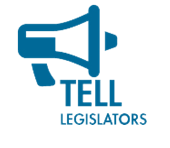




 */ ?>
*/ ?>














